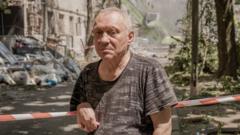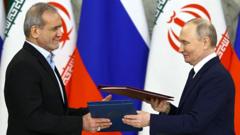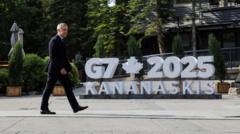Despite the Kremlin's announcement of a short-lived Easter truce, skepticism runs high in Ukraine regarding its true intentions, while diplomatic efforts continue to seek a resolution to the conflict.**
Assessing Putin's Easter Truce: A Step Towards Peace or Mere Facade?**

Assessing Putin's Easter Truce: A Step Towards Peace or Mere Facade?**
Tensions escalate as questions arise over the sincerity of Putin's declared Easter truce amid ongoing fighting in Ukraine.**
In a recent declaration that has stirred both hope and skepticism, Russian President Vladimir Putin announced a unilateral Easter truce in Ukraine, effective for a mere 30 hours, until midnight Sunday in Moscow. This move comes amid intensified military attacks by Russia, combined with diplomatic efforts aimed at negotiating peace, primarily facilitated by the Trump administration, which proposed a much longer ceasefire of 30 days that Ukraine accepted but Russia rejected alongside numerous conditions.
Putin’s Easter truce was framed as a humanitarian gesture, but the response from Ukraine has been markedly skeptical. On social media, Ukrainian President Volodymyr Zelensky commented that the Russian military appears to be manipulating perceptions of an actual ceasefire while still conducting operations in certain regions. Meanwhile, Russia's defense ministry maintains that its troops complied with the ceasefire terms, blaming Ukraine for alleged violations.
Analyzing the dynamics of this brief respite, some critics speculate that it serves more as a public relations maneuver by the Kremlin to project an image of being conducive to peace, especially with diplomatic relations with the U.S. seemingly thawing under the current administration. Recent statements from U.S. officials, including Trump, indicate frustration over the stagnation of peace negotiations, prompting speculation that Putin’s truce is a tactic to avoid further U.S. displeasure.
However, the announcement of the Easter truce, albeit unexpected, comes amidst an environment of high-stakes international diplomacy. The recent meetings between voice of Trump envoy Steve Witkoff and high-ranking Russian officials have fueled hopes for a potential breakthrough. The gathering of key diplomatic figures in Paris, including representatives from both Ukraine and the U.S., suggests that there might be more strategic discussions underway that are not yet visible publicly.
Despite ongoing conflicts reported even after the truce was declared, there lingers a glimmer of optimism that this brief ceasefire could pave the way for a more comprehensive agreement. Historical precedent suggests that negotiations often take place behind closed doors with outcomes that can surprise observers when least expected. As the situation unfolds, the world watches closely, contemplating whether this 30-hour pause could evolve into meaningful progress towards lasting peace in a region beset by turmoil.





















